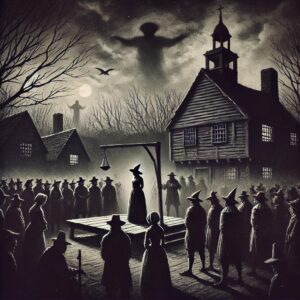The Salem Witch Hunt is one of the most infamous chapters in American history, a cautionary tale of how fear and suspicion can destroy lives and communities. Taking place in 1692 in the Puritan town of Salem, Massachusetts, the witch trials were a grim reflection of the dangers of mass hysteria, religious extremism, and the miscarriage of justice. The trials led to the execution of 20 people and the imprisonment of many others, all based on shaky accusations of witchcraft.
The climate in Salem was ripe for panic. It was a deeply religious society, with a strict moral code. Puritan leaders believed that evil was constantly at work, and that the devil could possess anyone. At the time, this idea was not just a superstition but a fundamental belief. Combined with political instability, fears of Native American attacks, and disease, these tensions created a perfect storm of anxiety.
The witch hunt began when a group of young girls in Salem Village started behaving strangely, claiming they were being possessed by the spirits of witches. Their strange fits and convulsions were seen as evidence of supernatural forces. These accusations quickly spiraled out of control as more and more people, especially women, were accused of practicing witchcraft. The accused were subjected to trials that lacked fairness or reason, with the word of the accusers often taken as irrefutable evidence. Many confessed under the pressure of torture, fear of death, or the hope of saving their families.
The community’s fear of witchcraft was not new. In Europe, tens of thousands of people had been executed as witches, and the paranoia had crossed the Atlantic. In Salem, the fear spread like wildfire, with neighbors turning on one another. Those who were different or held grudges were often targeted, and accusations became a weapon in personal conflicts. The trials were a reflection of the fear of the unknown, fear of outsiders, and a community under great stress.
However, the madness did not last forever. As the hysteria mounted and more innocent lives were destroyed, some began to question the legitimacy of the accusations. Judges and leaders, including the governor of Massachusetts, eventually intervened, bringing an end to the trials. Years later, the community expressed regret over the trials, and the court acknowledged that the trials were a mistake, but the damage was already done. The Salem witch trials remain a dark stain on the American conscience, a reminder of how easily fear can lead to injustice.
Even today, the term “witch hunt” is used to describe situations where paranoia and fear are used to scapegoat and persecute the innocent. The Salem trials teach us to be vigilant in safeguarding justice, and to resist the dangers of mass hysteria and fear-based actions. History may have moved on from the dark days of Salem, but the lessons remain as relevant as ever.

